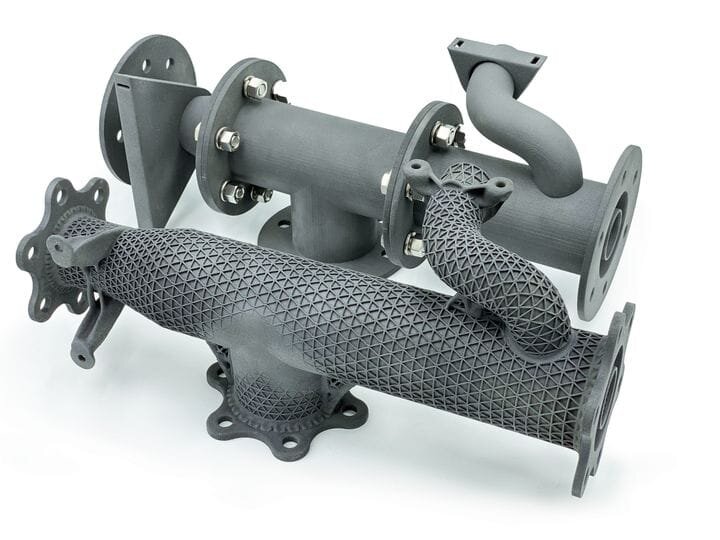![nTopology’s nTop Platform produced the design for this highly complex industrial part [Source: nTopology]](https://fabbaloo.com/wp-content/uploads/2020/05/image-asset_img_5eb08cf2e1260.jpg)
nTopology released the latest version of their nTop Platform software, 2.0.
The NYC-based startup company has been working on their powerful 3D CAD solution for about five years now, but has been making big waves in the industry.
Their approach is radically different that I believe they have a challenging time explaining what they are doing to prospective clients. I’ll try my best to describe their approach.
3D Model Challenges
The problem nTopology is attacking is the extreme difficulty in handling highly complex 3D models. Most CAD systems internally represent 3D models as collections of solid pieces in some form. STL, the still unfortunately de facto 3D printing interface standard, stores a 3D model as a huge number of (hopefully) adjacent triangles that represent the “skin” of an object.
While these representational approaches do work well (um, except for STL) in most simple cases, they break down horribly when things get complex. That hasn’t been an issue until relatively recently.
3D Printing Requires Complex 3D Models
The advent of powerful, high resolution production 3D printers in both plastics and metal materials has enabled manufacturers to finally leverage the true capabilities of 3D printing for their products. But that leveraging almost always involves using highly complex 3D models.
An example could be Carbon’s arrangement with Adidas to produce a 3D printed midsole that is essentially a large, complex lattice structure. It’s lightweight, uses less materials, is fully functional and it looks cool.
But it’s also incredibly complex. The 3D model for such object types are monstrously gigantic and thus take correspondingly huge amounts of processing to handle them.
If they can be handled at all.
It’s a frequent requirement that extremely powerful workstations be available to process such huge 3D models, and even then it is challenging to do so.
nTopology’s nTop Platform
![nTopology’s nTop Platform produced the design for this highly complex cycling seat using digital foam [Source: nTopology]](https://fabbaloo.com/wp-content/uploads/2020/05/image-asset_img_5eb08cf32ed60.jpg)
nTopology’s nTop Platform changes all of this.
Instead of representing a 3D model with an endless series of small components, they use mathematical formulae to essentially generate the 3D model on the fly. This is the part where the math is beyond my skill level, but trust me, it works.
The result is that they are able to manipulate extraordinarily complex 3D models in only seconds, whereas conventional tools would only cause smoke to come out of your computer.
3D Printing STL Challenges
This mathematical approach provides a number of advantages, as you can imagine, but the system’s power extends beyond the software. Imagine a workflow where you swiftly generate a complex 3D model in nTopology, and then want to 3D print it. Normally, you’d export it to the burdensome and awful STL format for slicing and then 3D printing.
However, once you move to STL you’re screwed again, as you’ve just lost all the speed advantages and re-introduced the representation problem. nTopology has solved this issue by providing slicing directly in their system! This also can be done in rapid time, as the slicing can take advantage of their superior internal digital representation.
nTopology has made arrangements to deliver slices directly to certain equipment models, including Renishaw and EOS, with rumors of more coming soon. This entirely bypasses the STL problem and greatly speeds the workflow.
nTopology nTop Platform 2.0 also leverages their speedy internal 3D model representation by adding what the company calls “toolkits”. These are bundles of common pre-packaged functions that focus on typical design scenarios. Here is a list of the toolkits included:
Lightweighting Toolkit
-
Quickly and easily reduce the weight and maximize the performance of parts.
-
Shell parts in seconds no matter how complex the geometry.
-
Apply variable wall thickness to shelled parts.
Architected Materials Toolkit
-
Engineer functional materials that perform at any scale—hundreds of unit cells, or hundreds of billions.
-
Design with multifunctional requirements from the start. Structural, thermal, acoustics, or aesthetics; all with total control at any length scale.
-
Optimize unit cells to create unique material properties to perfectly suit the application. Increase surface area while reducing weight. Turn geometric complexity into a competitive advantage.
Design Analysis Toolkit
-
Use fully integrated simulation capabilities to seamlessly analyze parts in a single, connected workflow.
-
Drive geometric parameters directly from simulation results to achieve high-performance parts that meet functional requirements.
-
Integrate with the simulation tools an organization already uses, including ANSYS, Abaqus, and Nastran.
Topology Optimization Toolkit
-
Discover new and innovative designs early in the product development cycle.
-
Apply multiple loading conditions and optimize for a variety of performance criteria including stress, displacement, stiffness, and weight.
-
Use automated geometry reconstruction tools to quickly generate instantly editable geometry.
Additive Manufacturing Toolkit
-
Position, orient and prepare parts for additive manufacturing from a set of common build platforms.
-
Add lattice support structures easily and quickly
-
Slice parts avoiding error-prone STL files and export manufacturing data directly to machines
-
It’s also possible to author custom toolkits for specific scenarios, making the approach quite extendable.
Imagine being able to perform these functions at high speed on a very complex 3D model. That’s where nTopoloogy is headed.
Via nTopology

